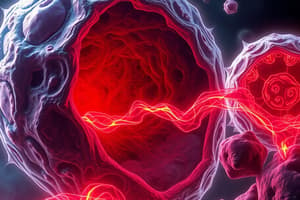Podcast
Questions and Answers
Which process is characterized by the activation of caspase-3 as part of its execution?
Which process is characterized by the activation of caspase-3 as part of its execution?
- Necrosis
- Cellular Senescence
- Autophagy
- Apoptosis (correct)
What is the primary function of Bcl-2 in relation to apoptosis?
What is the primary function of Bcl-2 in relation to apoptosis?
- Inhibits apoptosis (correct)
- Stimulates autophagy
- Promotes necrosis
- Activates caspases
Which component is directly involved in the formation of the apoptosome?
Which component is directly involved in the formation of the apoptosome?
- Cytochrome c
- Procaspase-9
- Bax
- Apaf-1 (correct)
In which of the following scenarios would autophagy be favored?
In which of the following scenarios would autophagy be favored?
What is the key difference in DNA fragmentation between necrosis and apoptosis?
What is the key difference in DNA fragmentation between necrosis and apoptosis?
Which protein is responsible for the release of cytochrome c from mitochondria during apoptosis?
Which protein is responsible for the release of cytochrome c from mitochondria during apoptosis?
What role does cyclophilin D play in apoptosis?
What role does cyclophilin D play in apoptosis?
Which process would be primarily active in response to severe cellular stress, such as oxygen deprivation?
Which process would be primarily active in response to severe cellular stress, such as oxygen deprivation?
Which event marks the commitment point in the intrinsic pathway of apoptosis?
Which event marks the commitment point in the intrinsic pathway of apoptosis?
Flashcards are hidden until you start studying
Study Notes
Comparison of Necrosis, Apoptosis, and Autophagy
- Necrosis: Uncontrolled cell death due to external factors like injury or infection; often results in inflammation.
- Apoptosis: Programmed cell death; essential for normal development, maintaining homeostasis, and removing damaged cells; generally does not provoke inflammation.
- Autophagy: Cellular self-digestion process; helps in recycling cellular components and responding to stress; can lead to cell survival or cell death depending on context.
Main Steps of Each Process
- Necrosis:
- Cellular swelling
- Membrane rupture
- Inflammation in the surrounding tissue
- Apoptosis:
- Initiation (extrinsic or intrinsic signals)
- Activation of caspases
- Cell shrinkage
- DNA fragmentation
- Phagocytosis by neighboring cells
- Autophagy:
- Formation of autophagosomes
- Fusion with lysosomes
- Degradation of cellular components
- Recycling of materials
Activity Matching
- Death Domains: Involved in receptor-mediated apoptotic signaling.
- Procaspase-3 and Caspase-3: Executioner caspase involved in the apoptosis pathway.
- Procaspase-8 and Caspase-8: Initiator caspase activated in extrinsic apoptosis.
- Procaspase-9 and Caspase-9: Initiator caspase activated in intrinsic apoptosis.
- Bax: Pro-apoptotic protein that promotes cytochrome c release from mitochondria.
- Apoptosome: Complex formed to activate procaspase-9 during intrinsic apoptosis.
- Cyclophilin D: Regulates mitochondrial permeability transition; involved in necrosis.
- MPTP (Mitochondrial Permeability Transition Pore): Associated with necrosis; leads to loss of mitochondrial membrane potential.
- Cytochrome c: Released from mitochondria to activate the apoptosome.
- Apaf-1: Key component of the apoptosome; activates procaspase-9.
- Bcl-2: Anti-apoptotic protein; regulates the release of cytochrome c.
Favoring and Inhibiting Conditions
- Necrosis:
- Favored by severe cellular damage, lack of blood supply, and toxins.
- Inhibited by proper cellular repair and immune response.
- Apoptosis:
- Favored by stress signals, DNA damage, and developmental cues.
- Inhibited by survival factors, such as growth factors or Bcl-2.
- Autophagy:
- Favored during nutrient deprivation and stress conditions.
- Inhibited by nutrient-rich environments.
Consequences for Molecular Processes
- Changes in apoptosis or autophagy can lead to cancer progression, neurodegenerative disorders, or autoimmune diseases.
- Impaired necrosis clearance can contribute to chronic inflammation and tissue damage.
- Proper execution of these processes is crucial for maintaining cellular homeostasis and preventing disease.
Actions of Specific Components
- Death Domains: Trigger apoptotic signaling cascades.
- Procaspases and Caspases: Execute apoptosis through proteolytic activity.
- Bax: Facilitates mitochondrial dysfunction and promotes apoptosis.
- Apoptosome: Activates executioner caspases.
- Cyclophilin D and MPTP: Induce necrotic cell death through mitochondrial damage.
- Cytochrome c and Apaf-1: Central to the apoptotic signaling pathway.
- Bcl-2: Protects against apoptosis by stabilizing mitochondria.
Consequences of Changes in Components
- Inhibition of caspases leads to decreased apoptosis, potentially resulting in tumorigenesis.
- Overactivation of apoptotic pathways can cause excessive cell loss in tissues, contributing to degenerative diseases.
- Changes in Bcl-2 expression can shift the balance towards cell death or survival.
Apoptosis Induction Mechanisms
- Intrinsic Pathway: Triggered by internal stress signals, involves mitochondrial changes, Bcl-2 family interactions, and cytochrome c release.
- Extrinsic Pathway: Activation via death receptors on the cell surface; involves Fas ligand and initiator caspases.
- Key Mediators:
- Bcl-2: Prevents cytochrome c release.
- p53: Promotes apoptosis in response to DNA damage.
- Timing and Stages: Rapid activation of caspases following initiation, distinct morphological changes, and eventual phagocytosis.
Role of the Caspase Cascade
- Caspases play a critical role in the initiation and execution of apoptosis; their activation leads to cell dismantling and death.
Role of Mitochondria in Apoptosis
- Mitochondria regulate the release of pro-apoptotic factors like cytochrome c and play a central role by influencing caspase activation.
DNA Consequences
- Apoptosis involves programmed DNA fragmentation, a feature distinguishing it from necrosis, where DNA breakdown is chaotic and uncontrolled.
Role of Apoptosis and Autophagy in Development
- Both processes are vital for normal development, cellular differentiation, and homeostasis; apoptosis removes unwanted cells, while autophagy maintains cellular quality and nutrient balance.
Studying That Suits You
Use AI to generate personalized quizzes and flashcards to suit your learning preferences.




